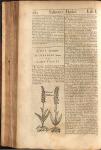This chapter hasn't been proofread yet.
I. The Names. This Plant, as far as I can
JL learn, was wholly unknown to the Greeks vet modern Authors have given it this Greek. Name, 'λπυ&κΌμη, Argyrocome, (i. e. Silver-leav'd : ) in Latin it is called, Gnaphalium Americanum _·, and in Englfo, American Cudweed, also Live-long, and L.je-everlasting.
II. The Kinds. It is a singular Plant of the kind : and is accounted one of the Species of Gnaphalium Carolus Clusius, from the Likeness of the Umbles or Tufts of Heads, tho' they are greater and whiter than those of the other kinds ot Cudweed ; all of which are of kin to the Golden Tufts. This Plant has been called by some of our English, Live-long and Life-ever lasting, because of the Durability or long Duration of their Flowers in their Beauty.
III. The*Description. This Silver Tuft or Indian Cottonweed, has Roots which are long, and blac/i on the outside, creeping very much under Grou?id: from whence spring up many white Heads of Leaves, covered with a hoary Woolliness, like Cotton, which rising into hard, thick, round Stalks, contain \\ill the same Hoariness upon them, as also upon the long and narrow Leaves which grow thereon, more especially on the under side; for the upper sides are of a dark shining green color. The Stalks are divided at the top into many small Branches, each of which have many scaly, tufted Heads set together, covered over with Cotton before their opening, and then parting one from another, abiding very white on the outside when they are fully grozon, but with a small yellow Thrumb in the middle of each Flower, which in time will turn into yellow Down, apt to be blown away with every Wind.
IV. Gerard says, that this Plant is of greater Beauty than the rest, and has straight upright Stalks, three feet high or more, covered with a moil soft and fine Wooll, and in such a plentiful manner, that a Man may with his Hands take it from the Stalk in great quantity. This Stalk is beset with many long and narrow Leaves, green on the inner side, and hoary on the other side, somewhat like in Form to Rosemary Leaves, but greater. The Flowers do grow at the tops of the Stalks in Bundles or Tufts, consisting of many small Flowers of a white color, and very double or compatt, or as it were consisting of little Silver Scales thrust dofe together, which do make the same vety double. When the Flower has long flourished, and is grown old, then comes there, in the midst of the Flower, a certain brown yellow Thrumb, such as is in the midst of the Daisy : which Flowers being gathered when they are young, may be kept in such manner as they were gathered, to wit, in such Freshness and good Color, for the jpace of a whole Year after, and that in a dofe Cbijl or else-where ( from this long keeping of their freshness and Color, it was, that our Engltih Gentlei^vien called it Live-long, &t> to which, on this occaficn, it very
l Φ) answers. γ
V. The Places. It grows plentifully in America, in several parrs of the West Indies. I found it growing in some of the Southern parts of Carolina. It grows naturally near unto the Mediterranean Sea, from whence it has been brought and planted in our English Gardens, Bauhinus says, that it grows frequently in Brasil: but Clusius, who fifft let it forth by the Name of Argyrocome or Gnaphalium Americanum, had his Plants out of England. We have also had it brought to us out of Florida, so that now it grows well and plentifully with us, if Care be taken of it by a skilful Gardener.
VI. The Times. It flowers in June and July, and the Seed is ripe in August.
VII. The Qualities, Specif cation, Preparations and Virtues of this, are the same with the last and the others aforegoing, and therefore referr you to Chap. 180. for full Satisfaction.
Botanologia, or The English Herbal, was written by William Salmon, M.D., in 1710.

 Page 297
Page 297 Page 298
Page 298